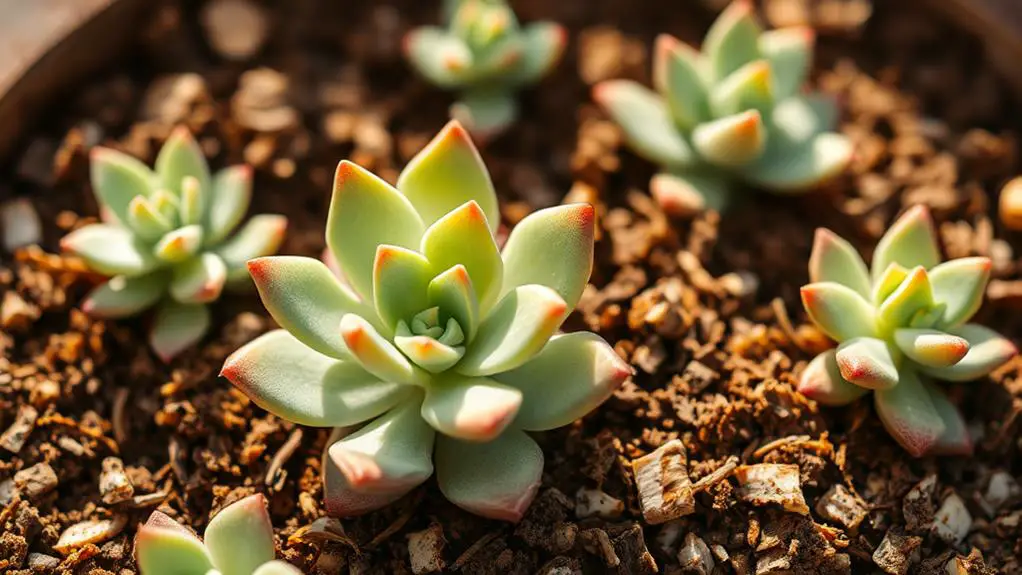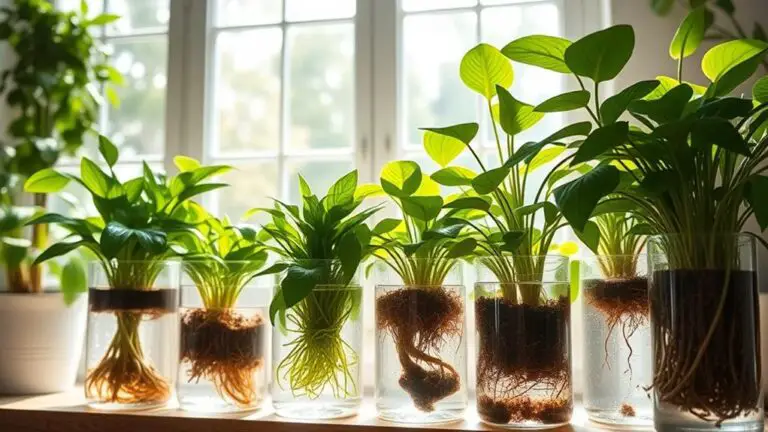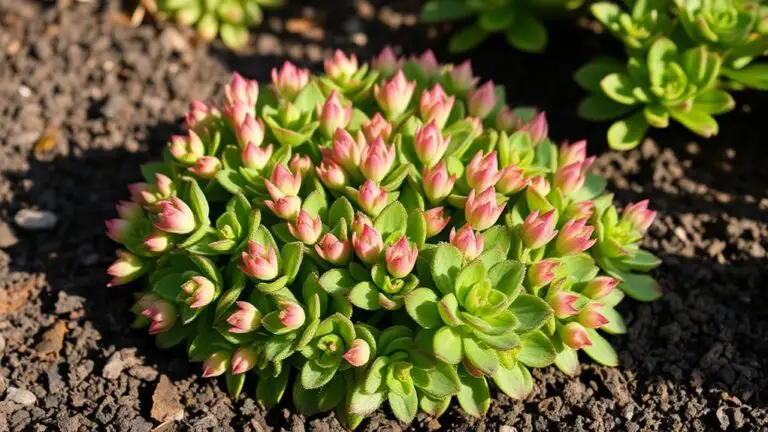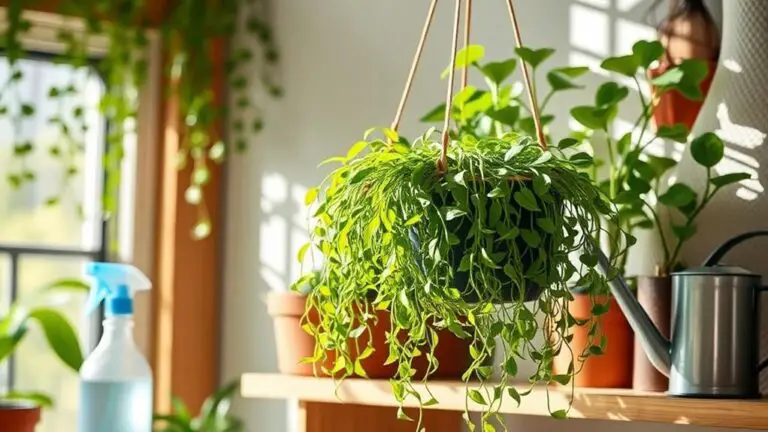7 Essential Tips for Using Coconut Coir With Succulents
When it comes to nurturing your succulents, utilizing coconut coir can be a game-changer. You need to start by choosing the right type of coir and mixing it with mineral components like perlite or pumice for ideal drainage. But that's just the beginning. How you adjust this mix based on your climate and monitor moisture levels can greatly affect your plants' health. There are several nuanced tips that can help you prevent root rot while ensuring robust growth. Curious about how you can make the most out of this natural material for your succulents?
Choose the Right Coir
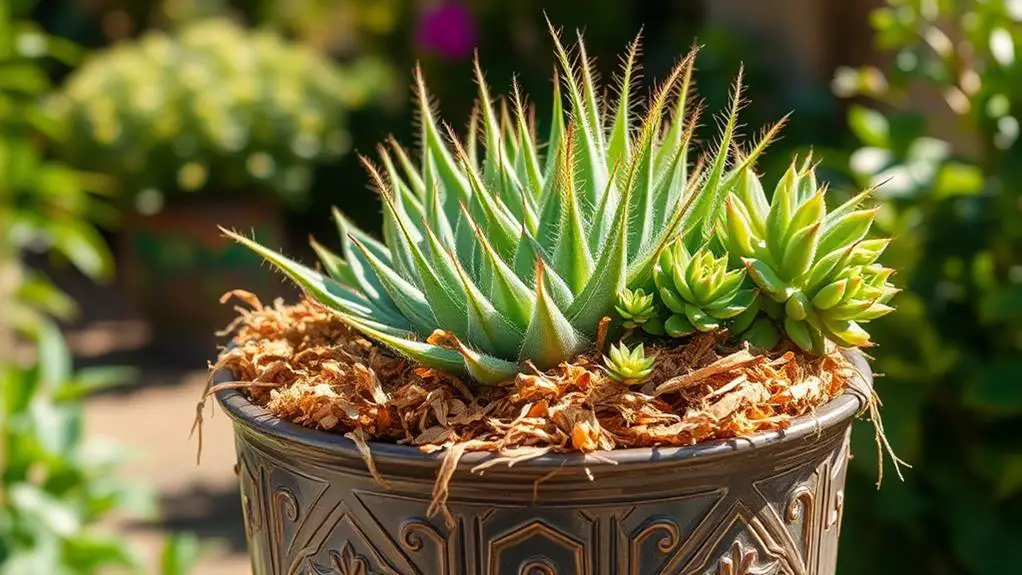
When you're selecting coconut coir for your succulents, it's important to opt for premium horticultural-grade coir that's pre-rinsed to remove salts. This guarantees your sensitive plants won't be harmed by any residual salt content.
You'll find coir products in different forms, like compressed bricks and loose fiber. If you choose the compressed bricks, remember they need about 21 liters of water per 4 kg to rehydrate them properly.
Choosing the right coir is vital because it provides excellent moisture retention, similar to peat moss, but it's more environmentally friendly. Look for lightweight and biodegradable coir, as it offers good soil structure while being kind to the planet.
Always verify the coir is free from contaminants and has been processed properly, as the quality can vary between suppliers.
For your succulent mix, a good rule of thumb is to use coir at about 30-50%. This balance guarantees enhanced drainage and aeration, which are significant for succulent health.
Combining coir with other materials like perlite or pumice creates a mix that retains moisture just enough without waterlogging the roots. By choosing the right coir, you're setting the stage for a thriving succulent garden.
Mix With Mineral Components

To improve soil drainage and enhance root aeration for your succulents, mixing coconut coir with mineral components like perlite or pumice is a great idea.
This mix balances moisture levels, ensuring your plants get the hydration they need without becoming waterlogged.
Aim for a ratio of 1 part coir to 2 parts coarse mineral grit to promote healthy root growth and prevent compaction.
Improve Soil Drainage
Enhancing soil drainage is crucial for succulents, and mixing coconut coir with coarse mineral components like perlite or pumice can greatly improve it. Coconut coir absorbs water effectively, holding moisture for the roots while preventing the soil from becoming overly saturated when combined with gritty minerals. This combination guarantees that your potting mix has an ideal balance of moisture retention and drainage, promoting healthy root systems.
To achieve this, blend 30-50% coconut coir with 50-70% mineral materials like pumice or coarse sand. This mix not only improves drainage but also creates a well-balanced soil structure. The mineral components help water escape quickly, preventing root rot and other issues associated with poor drainage.
Here's a simple table to help you understand the recommended ratios:
| Coconut Coir | Mineral Materials | Outcome |
|---|---|---|
| 30% | 70% | Excellent drainage, moderate moisture retention |
| 40% | 60% | Balanced drainage and moisture retention |
| 50% | 50% | Good drainage, higher moisture retention |
Enhance Root Aeration
A healthy root system thrives on good aeration, and combining coconut coir with mineral components like perlite or pumice guarantees that your succulents get the oxygen they need. By mixing 30-50% coconut coir with 50-70% mineral grit, you can create a potting mix that excels in soil aeration. This mix assures that your succulents' roots have access to fundamental oxygen while also benefiting from fast drainage and moisture retention.
Coconut coir's fibrous structure plays an essential role in preventing compaction. It maintains soil porosity, creating air pockets critical for root respiration.
When you blend coconut coir with coarser materials like builders sand or fine gravel, you enhance both moisture retention and drainage. This balance is key to the health of your succulents, helping them flourish.
Balance Moisture Levels
Building on the benefits of enhanced root aeration, it's equally important to balance moisture levels when using coconut coir with succulents. Coir retains up to five times its weight in water, so mixing it with mineral components like perlite or pumice is essential. Aim for a ratio of 30-50% coir to guarantee proper drainage while maintaining moisture availability.
Adding coarse sand or fine gravel to your soil mixes helps create an environment where excess water can easily drain away, preventing root rot. This combination guarantees that your succulents get the moisture they need without becoming waterlogged.
In humid climates, this mix is even more critical, as it prevents the soil from becoming too compact and promotes healthy root growth.
Regularly monitor the moisture levels in your soil. Coir's moisture-retaining properties can sometimes lead to overwatering if not balanced correctly. By incorporating enough gritty materials, you'll guarantee that your succulents thrive with just the right amount of water.
Adjust Based on Climate
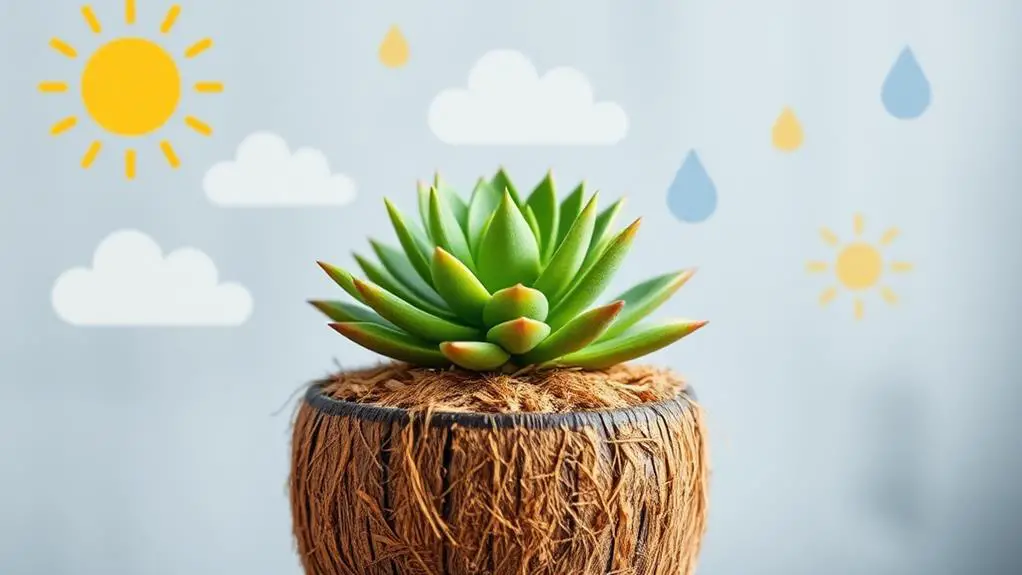
To keep your succulents happy, adjust your coconut coir mix based on your local climate.
In humid areas, adding gritty materials like pumice can improve drainage and prevent soggy roots.
If you live in a dry place, more coir helps retain moisture and keeps your plants hydrated longer.
Humidity and Watering Needs
Ever wondered how to keep your succulents happy in different climates? Understanding their humidity and watering needs is key.
Coconut coir can be your best friend when it comes to managing moisture levels, especially in humid environments. Coir retains moisture well, which helps your succulents stay hydrated without getting waterlogged. This is important because too much water can lead to root rot.
In humid climates, mixing coconut coir with gritty soil can regulate moisture levels effectively. This combination provides excellent drainage, ensuring your succulents don't sit in water for too long. You'll find that you don't need to water as often since the coir holds onto the right amount of moisture.
On the other hand, if you're in a dry climate, try using a lighter mix with more coarse minerals and less coir. This helps the soil drain faster, preventing excessive water retention.
Regularly check the moisture levels in your coir-based mix, as it can hold water longer than you might expect.
Temperature and Soil Choice
Understanding the humidity and watering needs of your succulents sets the stage for optimizing their temperature and soil conditions. In hot climates, coconut coir in your soil mix helps maintain cooler temperatures, reducing heat stress on your plants. Coconut coir retains moisture effectively, which is a big plus in arid environments. It keeps your succulents hydrated without making the soil too wet.
For indoor succulents, humidity levels can be tricky. You'll want to adjust the coir ratio in your soil mix to improve drainage. A good mix might be 1 part coir to 2 parts mineral grit. This combination guarantees that excess moisture doesn't harm your plants.
If you're planting outdoors in humid areas, you'll need a soil mix with more mineral content for rapid drainage. Try using 70% gritty components and 30% coir. This mix prevents water from sitting in the soil too long, which can cause root rot.
Monitoring moisture levels in coconut coir is vital. Its water retention varies with local climate conditions, so you may need to adjust your watering frequency.
Use for Propagation
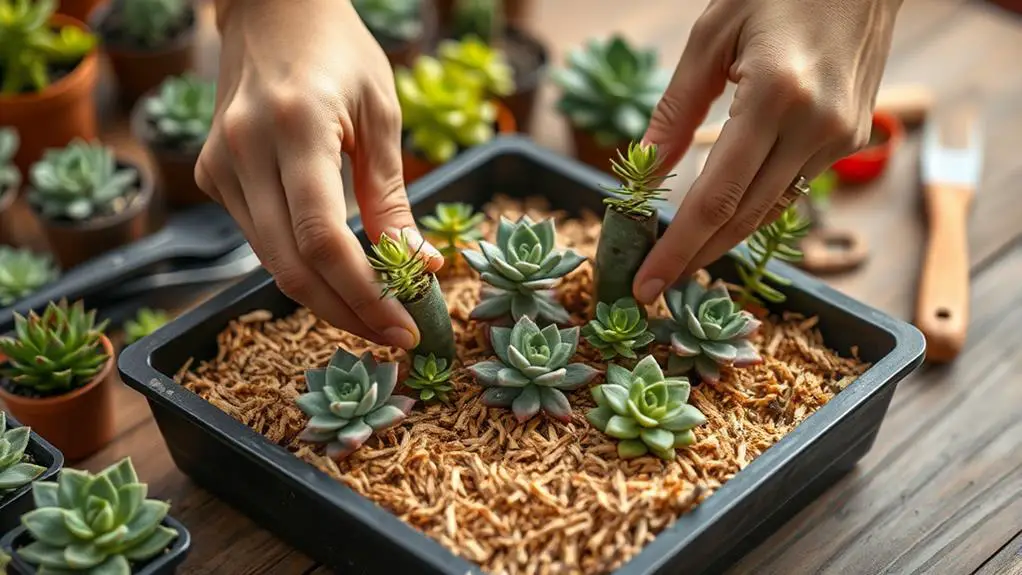
Propagating succulents can be a rewarding endeavor, especially when using coconut coir. This medium is perfect for propagating from leaves because it retains moisture while providing excellent drainage, promoting successful rooting. When you're working with new leaf cuttings, using coir exclusively gives them a stable environment for root development.
To enhance the process, consider mixing coconut coir with gritty components. This combination improves moisture retention and aeration, which is particularly beneficial if your succulents struggle during propagation. Gritty components, like perlite or sand, help balance the moisture levels and give roots space to grow.
If you live in hot climates, coir's organic composition is a bonus. It keeps soil temperatures cooler, reducing stress on new cuttings and improving rooting success. This makes a huge difference in guaranteeing your succulents thrive even under intense sunlight.
For trailing succulents that need tight root systems, layering coir on top of a gritty mix can provide the perfect balance. This method guarantees healthy growth while maintaining adequate moisture levels.
Monitor Moisture Levels
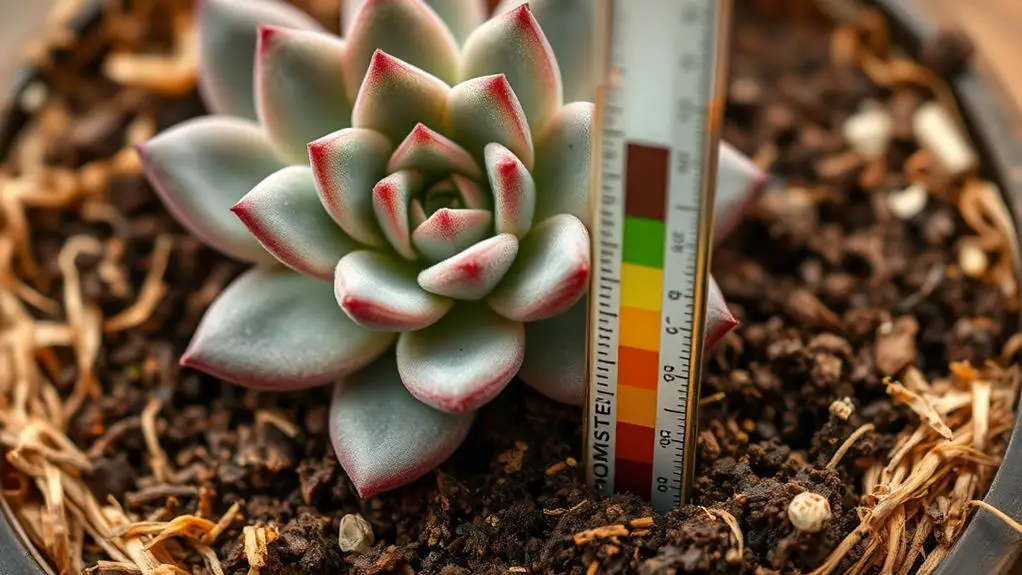
After successfully propagating your succulents with coconut coir, it's important to monitor moisture levels to guarantee healthy growth.
Coconut coir can retain up to five times its weight in water, which means you need to be watchful to avoid over-saturation and root rot in your succulents. Proper moisture management is key to preventing these issues.
Here are some helpful tips:
- Regular Checks: Regularly check the moisture content in your coir mix. This is especially important in hot climates where coir can dry out quickly while still providing adequate moisture retention.
- Watering Frequency: Adjust your watering frequency based on the moisture level of the coir. Succulents generally prefer to dry out completely between waterings. Since coir retains moisture even after drying, it helps you manage this more easily.
- Use Your Senses: Feel the coir with your fingers. If it feels damp, hold off on watering. If it's dry, it's time to give your succulents a drink. This tactile method can be very effective.
- Avoid Root Rot: Be cautious about overwatering. Coconut coir's moisture retention is beneficial, but too much water can lead to root rot, which is harmful to your succulents.
Enhance Aeration
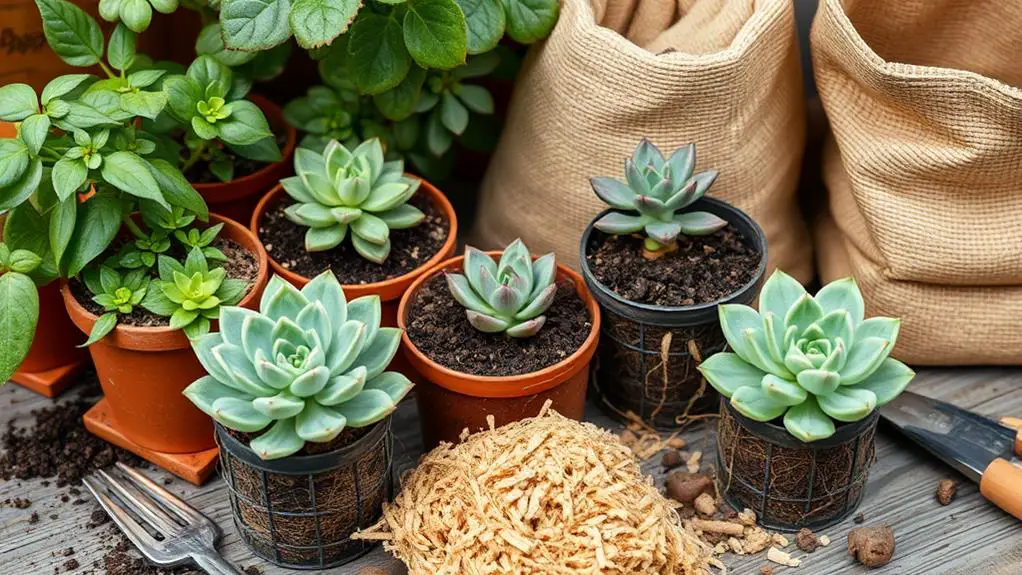
Ensuring proper aeration in your succulent's growing medium is fundamental for their overall health and vigor. Coconut coir is a fantastic choice because it maintains its structure longer than peat moss. This means you'll have consistent aeration for your succulent roots without worrying about the medium compacting over time.
The fibrous nature of coconut coir creates air pockets in the soil. These air pockets are essential as they promote healthy root respiration, allowing your succulents to breathe and support photosynthesis.
To enhance aeration even further, consider mixing coir with gritty materials like perlite or pumice. This combination not only boosts aeration but also provides excellent drainage, which is critical for succulent needs.
Using coconut coir makes the potting medium lightweight and easy to handle. Mixing it with other components to create a well-aerated potting medium becomes a breeze.
Remember, regularly monitoring and adjusting your coir mixtures can help maintain ideal aeration levels. This way, you can tailor the growing conditions to your specific succulent needs and local environment.
Prevent Root Rot
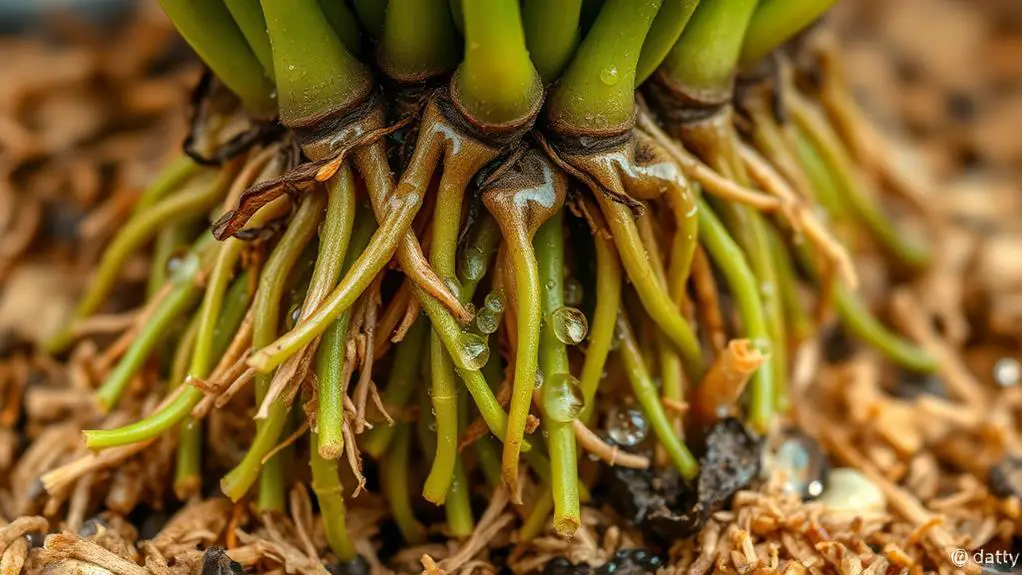
Root rot can be a major challenge when growing succulents, but you can effectively prevent it by using coconut coir. Coconut coir excels in moisture retention, allowing your succulents to rehydrate without becoming waterlogged. This balance is essential because succulents need to dry out between waterings to stay healthy.
Here's how to prevent root rot using coconut coir:
- Superior Moisture Retention: Coconut coir holds moisture better than peat-based soils, providing just the right amount of hydration without oversaturating your succulents. This helps prevent root rot, a common issue with overwatering.
- Excellent Aeration: The structure of coconut coir promotes great aeration, ensuring your succulent roots get enough oxygen. Good aeration is critical for preventing root rot since it stops roots from sitting in stagnant, oxygen-deprived soil.
- Well-Draining Mix: Combine coconut coir with gritty materials like pumice or perlite to create a well-draining succulent soil. This mix reduces the chances of water accumulation around the roots, further minimizing the risk of root rot.
- Sterile Growing Medium: Coconut coir is naturally sterile, lowering the risk of pathogens that cause root rot. This makes it a safe choice for both new cuttings and established plants.
Frequently Asked Questions
How to Use Coconut Coir for Succulents?
You should use coconut coir for succulents by mixing it with perlite or pumice for better drainage, layering it in pots for moisture, and rehydrating bricks properly. This helps maintain moisture and promotes healthy rooting.
Can Succulents Live in Coconut Fiber?
Yes, succulents can thrive in coconut fiber. It retains moisture well but still allows for good drainage. Coconut coir's organic composition and sustainability make it an excellent choice, supporting healthy root growth without excess nitrogen.
How Do You Activate Coconut Coir?
To activate coconut coir, soak compressed coir bricks in around 21 liters of warm water per 4 kg brick. Let it sit for 30 minutes to 1 hour. Make certain it's well-drained afterward to avoid excess moisture.
Do You Need to Add Anything to Coco Coir?
Yes, you should add materials like perlite or pumice to coconut coir to improve drainage and prevent root rot. Mixing in a slow-release fertilizer can also help provide essential nutrients for healthy plant growth.
Conclusion
By following these seven tips, you'll create a perfect environment for your succulents to thrive. Coconut coir is an excellent choice that enhances growth and health because it balances moisture and aeration. Remember to mix in minerals, adjust for your climate, and keep an eye on moisture levels. With a little care and attention, your succulents will flourish. You've got this—happy gardening!

